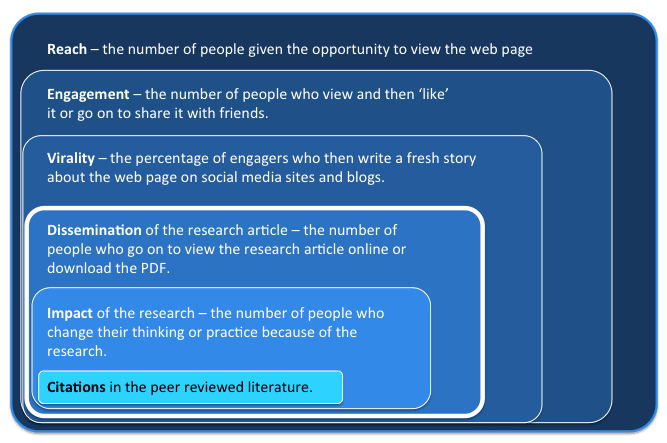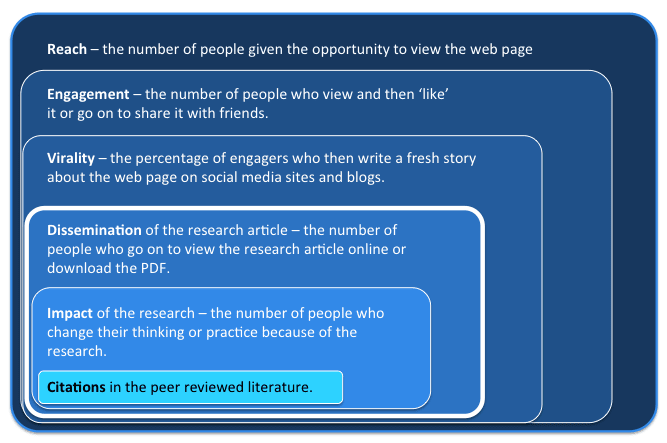A little while ago we ran an experiment looking at social media and whether it has any influence on people reading original research papers[1] (Lorimer is going to talk more about the actual experiment in the next blog). While we were in the process of considering our results I was surprised by the fact that there were no clear definitions of regularly used social media terms such as ‘reach’ or ‘impact’ or ‘going viral’. This became a problem not only when I tried to reference these terms as we were writing but also when I tried to explain to the team what these terms meant. It rapidly became clear that these phrases mean different things to different people so we set out to work on some definitions for ourselves so that we could then analyse our results.
For those of you who are interested, there is a new term which tries to capture online mentions of research articles called “altmetrics” originally defined by Jason Priem.[2, 3] Publishers such as Elsevier and PLoS are developing new altmetric tools which try to measure article mentions on sites such as twitter and blogs but as Priem notes
‘Researchers must ask if altmetrics really reflect impact, or just empty buzz’.[2]
These metrics are still in their infancy and as PLoS mentions many of the online social metrics are not always accurate.[4]
So what is the difference between reach and impact? The idea of social media reach is fairly straightforward – it can be considered as the number of people in a network, for example the number of Facebook friends or Twitter followers. A blog may have 2,000 Facebook ‘likes’, 700 Twitter followers and 300 subscribers – a reach of three thousand people. The end goal, to change people’s behaviour (impact), however, is less straightforward. So, these are the definitions we came up with and then Lorimer came up with a posh diagram to capture it.
We took ‘reach’ to be the number of people who have been alerted to the presence of a web page and have the opportunity to view it. Reach reflects the number of people who could potentially see the blog, either directly because they subscribe to the blog through RSS feed or email alerts, or through following the blog on various social media sites for example Facebook, Twitter, LinkedIn, Google+ or ResearchBlogging.
One step closer to impact is engagement, defined here as the number of people who view the web page and then do something in response to viewing it – for example they ‘like’ it, re-tweet it, or they share it with their friends.
The concept of ‘virality’ attempts to capture a stronger level of engagement and a reflection of the propensity of the message to ‘go viral’. Here we use the percentage of engagers who then write a story on the post on Facebook or begin a new tweet. This distinction between terms is important because as few as 16% of Facebook followers actually read a new post and about 1% of people who see and ‘like’ a Facebook page actually comment on it or start a new story on it. [5]
The final two terms, dissemination and impact, are what we were actually trying to achieve, to increase the number of people who go on to view the original research article (dissemination) and then change their thinking or practice because of the research (impact – we have yet to figure out how to measure this).
Why is this important? Because the question we ask about the BiM website on a regular basis is the ‘so what’ question. Can we now say that one function of BiM is to increase the number of people who have access to, or get to know about, original pain research and then change their practice as a result? Lorimer answers this in the next blog post.
Here is a the full version of our paper.
About Heidi Allen
 We reckon that an all too common problem with ‘science’ is that it is only ever broadcast to ‘scientists’. Even then, it is often in journals that are read by a tiny proportion of the community. So, we sat down and thought ‘how can we better disseminate what we do – that is, how do we get the message out there, be a credible and interesting source of commentary on things to do with our research?’ How can we facilitate all those lovely ideas out there into research? Our answer: Heidi. Heidi has set up, run, bugged us all about contributing to this website. She reckons it will serve the aim of the group – to disseminate and facilitate research into the brain and mind in chronic pain disorders. We reckon she is right. Here she is, in person, talking about what she does at BodyInMind.
We reckon that an all too common problem with ‘science’ is that it is only ever broadcast to ‘scientists’. Even then, it is often in journals that are read by a tiny proportion of the community. So, we sat down and thought ‘how can we better disseminate what we do – that is, how do we get the message out there, be a credible and interesting source of commentary on things to do with our research?’ How can we facilitate all those lovely ideas out there into research? Our answer: Heidi. Heidi has set up, run, bugged us all about contributing to this website. She reckons it will serve the aim of the group – to disseminate and facilitate research into the brain and mind in chronic pain disorders. We reckon she is right. Here she is, in person, talking about what she does at BodyInMind.
References
[1] Allen HG, Stanton TR, Di Pietro F, & Moseley GL (2013). Social media release increases dissemination of original articles in the clinical pain sciences. PloS one, 8 (7) PMID: 23874810
[2] Priem J, Taraborelli D, Groth P, Neylon C. (2011) Altmetrics: a manifest. Altmetrics website.
[3] Jason Priem, Heather A. Piwowar, Bradley M. Hemminger (2012) Altmetrics in the wild: Using social media to explore scholarly impact .
[4] Jennifer Lin and Martin Fenner (2013) Let’s stop wandering the altmetrics grocery store. PLOS Tech blog.
[5] Creamer M (2012) Study: Only 1% of Facebook ‘Fans’ Engage With Brands. Adage website. Quoting a report by Ehrenberg-Bass Institute, UniSA.




